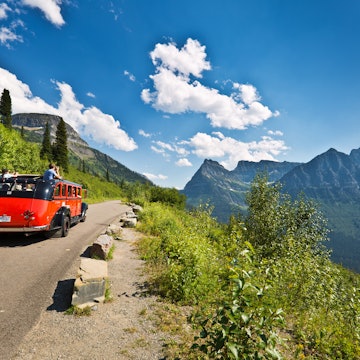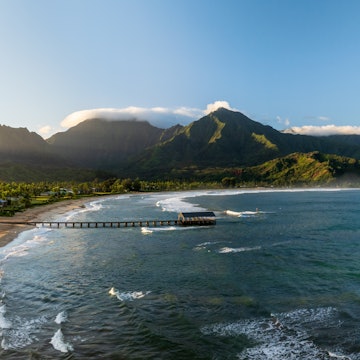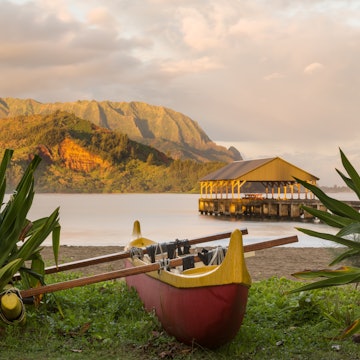
How to get around Maui with or without a car: travel on island time

Nov 30, 2021 • 7 min read

Traveling around Maui is best with a car, but there are several other transportation options to consider too © darekm101 / Getty Images
Ahh, Maui. So lush, so welcoming, so... full of cars. Yep, the Valley Isle is only 48 miles long and 26 miles wide, but it is hard to explore without a car.
Public transportation sticks to major towns, so you can’t get to Haleakalā National Park, the Road to Hana or ‘Iao Valley State Monument unless you have your own wheels or take a guided tour. Roads are often narrow and tight, and they are subject to frequent rains and winds, so cycling is challenging too.
The good news? If you don’t mind sticking to one small town or resort area, you can get around on foot or bicycle, or by riding the Maui Bus. Taxis and rideshare options work well for local travel too.
Top tip: as the local bumper stickers say, “Practice Aloha.” Remember that you are on island time. Slow down and dial it down a notch when traveling around the island. If you can't find parking at a waterfall on the Road to Hana, that’s okay. There’s another one down the road.
Car is the best option if you want to explore the island
The island of Maui is divided into five regions, each anchored by a town or small city. If you plan to travel beyond your region, you will want to rent a car. And unless you take a guided tour, you will need a car to visit Haleakalā National Park and to explore the Road to Hana (we recommend sticking to a guided tour for the latter to cut down on traffic congestion that has plagued the area for years).
There are nine international rental car companies at Kahului International Airport. A handful have offices in Ka‘anapali or inside different resorts. For a hybrid, electric, or biodiesel vehicle, consider Bio-Beetle in Kahului. Discount cars and motorcycle rental offices are scattered across the island. For an older car at a lower price, Kihei Rent a Car is a great choice. It offers complimentary rides to and from the airport.
The car rental market has always been tight and expensive on Maui, but the problem has been exacerbated after rental car companies sold off much of their inventory during the COVID-19 pandemic. Prices have dropped, but book your car a month or two in advance to ensure you’ll have one on arrival. A newer option is carsharing, which is available on Maui through Turo. The company has a wide variety of cars available. Mileage, pick-up instructions, and other details vary by host.

Look for road restrictions on your vehicle, especially if you plan to drive to a remote beach. Some of these can only be reached by a dirt road, and driving on unpaved surfaces may be prohibited. The tricky drive on the partially paved and sometimes rough Pi‘ilani Hwy through the Kaupo area may also be off-limits. Towing fees may be very high if you get stuck here.
Two-lane highways link most towns. Some may be narrow and subject to congestion at unexpected times. The main roads through downtown Lahaina and sprawling Kihei can also get very congested. Use the bypass outside of Lahaina or the Pi‘ialani Hwy in Kihei if you want to travel more quickly in either city.
It’s pretty easy to find street parking in Kihei and Kahului. Downtown Lahaina has street parking and a mix of paid and public lots. Check all signage about time limits and required payments.
Tip for beach parking: Resorts must provide public access to the beaches that front their property, Look for free parking lots near the public access points. In Ka‘anapali and Wailea these lots may be small and slightly hard to spot, but they are there.
It's easy to get around on foot in towns and resorts
In most coastal towns and resort areas, it is easy to get around by foot. Sidewalks navigate the historic core of Lahaina, while paved coastal trails link resorts and condo communities in Ka‘anapali, Kapalua and Wailea. The downtown areas of Pa‘ia and Makawao in the Upcountry are also pedestrian friendly. Sidewalks border much of S Kihei Rd, which is the main drag through Kihei, but the road stretches for almost 6 miles. The Maui Bus runs along S Kihei Rd, with frequent stops, so you could hop a ride if the walk is long.
A bus service links major towns
The Maui Bus runs within and between major towns, but it does not travel to out-of-the-way locations like Haleakalā National Park and Hana. The public bus system is managed by Roberts Hawaii and currently operates 14 routes. The main routes run every hour daily, roughly 7am to 8pm. The Upcountry Islander and the Haiku Islander stop at Kahului International Airport.
A one-way fare is $2, and a daily pass is $5. Children 5 years of age and younger travel free with a paying adult. Buses come with front-load bike racks.
A free shuttle operates between resorts in Ka'anapali
The Ka‘anapali Trolley is a free shuttle that loops between Whalers Village, the Ka‘anapali Golf Course, the Fairway Shops and several resorts every 20 to 30 minutes in Ka‘anapali. It is open to the public and operates between 10am and 10pm, with a lunch and dinner break for the driver. Larger resorts may provide shuttle service to guests around the resort area and to nearby towns.
Taxis and rideshares run in main towns
Taxis operate in the main towns and tourist areas, but they are easiest to find at the airport and outside larger resorts. You may need to call a dispatcher to find one in most towns and cities. Uber and Lyft are also available.

Cycling between towns is difficult
Traveling from town to town by bike will be challenging. Major roads are often very narrow, winds can be strong, traffic can be heavy and there are many hills and mountains. Sounds fun, right? Getting around a town by bike is feasible, but there aren't many bike lanes. Kihei is an exception. The city is mostly level, and there are bike lanes on its two main roads, S Kihei Rd and Pi‘ialani Hwy.
Bikes are available for rent in resort areas and in most major towns. Look for them at specialty bike shops or at stores that rent outdoor and recreational gear. Some hostels, guesthouses and B&Bs may also offer bikes for rent or loan. A handful of rental shops offer e-bikes.
There are twice-daily flights across the island
Mokulele Airlines flies twice daily between Kapalua International Airport and tiny Hana Airport in East Maui. This option cuts a two-hour drive to twenty minutes.
Guided tours go to various destinations and cut down on congestion
If you want to experience the Road to Hana or the sunrise at Haleakala and you don’t have a car to explore Maui, consider a guided trip. Roberts Hawaii, which also operates the county-run Maui Bus, offers trips to Haleakalā National Park, the Road to Hana and the Upcountry. Valley Isle Excursions leads Haleakalā and the Road to Hana trips. Polynesian Adventure Tours hit Haleakalā, the Road to Hana, the ‘Iao Valley and small towns in the Upcountry. Tours also have the added benefits of reducing traffic congestion and providing local insight from knowledgeable guides.

Ferries go to Lana‘i
The Expeditions Ferry links Lahaina Harbor with Manele Bay Harbor in Lana‘i, which is part of Maui County. The one-way ride is one hour, and the boat leaves several times daily. You may see spinner dolphins year-round and migrating humpback whales in winter. There is no ferry to Moloka‘i.
Most transportation in Maui is accessible
All vehicles used on Maui Bus routes are ADA accessible. Buses have ramps available and a sitting area in front. One-way fare for passengers with disabilities is $1. Some major rental car agencies rent hand-controlled vehicles and vans with wheelchair lifts. Another option is renting a wheelchair-accessible van through Wheelers of Hawaii or through Wheelchair Getaways.
Bring your disability parking placard from home. Hang it from your vehicle's rearview mirror when using designated disabled parking spaces.
Several tour companies run guided trips to Haleakalā National Park in ADA vans. Make a reservation at least four days in advance to secure a spot. Try Roberts Hawaii or Valley Isle Excursions. It is harder to find ADA-compliant guided tours to Hana because the stops on the Road to Hana are not easily accessible and some ADA vans cannot manage the narrow and twisty road itself.
You can also download accessible travel guides from Lonely Planet for more information.
You might also like:
These stunning Maui hikes visit waterfalls, rainforests and volcanoes
The best time to visit Maui for whale watching, hitting the beach or avoiding crowds
Maui's best beaches for swimming, snorkeling and soaking up the sun















